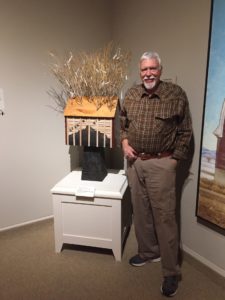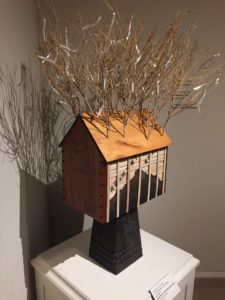A retired CSU faculty member’s sculpture memorializing a Japanese-American internment camp in northern Wyoming has been chosen for permanent display in the Whitney Western Art Museum at the Buffalo Bill Historic Center in Cody.

Peter Jacobs, a professor emeritus in the Department of Art and Art History, first visited the Heart Mountain Relocation Center in 2005. At the time, he was struck by the fact that there were only a few simple signs marking the site where more than 14,000 Japanese-Americans were kept between 1942 and 1945, surrounded by barbed wire and overseen by armed soldiers in guard towers. A few dilapidated, boarded-up buildings, a smoke stack and some random sections of concrete were all that was left of what was Wyoming’s third-largest city during most of World War II.
The following year, he met William Hosokawa, a retired Denver Post editor who had been incarcerated at the camp as a young man. Hosokawa, who had been editor of the camp’s newspaper and had written books about the Japanese-American experience, was in Fort Collins to deliver a lecture, and Jacobs approached him about his idea for a sculpture in honor of the camp. Hosakawa agreed to collaborate with him on the project.
The sculpture
That sculpture, “Spirit House — Heart Mountain 1942,” is a four-foot-high piece resembling a treehouse.  Two of its sides are rough, sawed boards with wind-torn tarpaper left over from barracks at the site. The tarpaper is arranged in the shape of the nearby mountain for which the camp was named, viewed through bars. But the two other sides of the house are highly finished pieces of mahogany, symbolizing the hard work and creativity that the Japanese-Americans used to turn an awful situation into a well-organized and functioning community. The camp not only had its own newspaper but boy and girl scout troops, a hospital, a post office, schools, a fire department and a police force.
Two of its sides are rough, sawed boards with wind-torn tarpaper left over from barracks at the site. The tarpaper is arranged in the shape of the nearby mountain for which the camp was named, viewed through bars. But the two other sides of the house are highly finished pieces of mahogany, symbolizing the hard work and creativity that the Japanese-Americans used to turn an awful situation into a well-organized and functioning community. The camp not only had its own newspaper but boy and girl scout troops, a hospital, a post office, schools, a fire department and a police force.
Those finished pieces of wood bear one of Hosokawa’s contributions: Jacobs asked him and his friends who were also incarcerated at Heart Mountain to write comments on the wood regarding the experience. Hosokawa took the boards to Denver and circulated them among those friends before his death in 2007. Jacobs expected neat lines of Japanese writing, and while the boards bear some of those, primarily they feature graffiti-like statements in English such as “Where is justice!” and “We are Americans.”
Symbolic meaning
The small house is supported on a guardhouse-shaped pedestal wrapped in barbed wire from the site. Sagebrush from the camp protrudes from the roof.
“That symbolizes the fact that nature is reclaiming these sites,” Jacobs said.
White prayer flags are tied to the brush, resembling the Shinto ribbons that Jacobs saw at a shrine during a 1998 trip to Japan.
“They represent a prayer that this never happens again,” Jacobs said. “Even though nature has largely taken over the site, we don’t want to forget. The flags are to remind us of what took place here.”
The site of the camp has changed since Jacobs first visited it: The National Historic Landmark is now home to a museum called the Heart Mountain Interpretive Center and walking trails connecting the original camp structures.
And one of the five museums at the Buffalo Bill Center in nearby Cody, the Whitney Western Art Museum, recently decided to display Jacobs’ sculpture as part of its permanent collection.
“It’s located between works by some really famous artists, so I’m pleased about that,” Jacobs said with a smile.
When the camp closed on Nov. 10, 1945, prisoners received a train ticket and $25.
In 1988, when the federal government approved the Civil Liberties Act that awarded reparations to surviving prisoners, former President Bill Clinton apologized for uprooting and imprisoning Japanese-Americans, attributing it to “racial prejudice, war hysteria, and a failure of political leadership.”
[masterslider id=”191”]